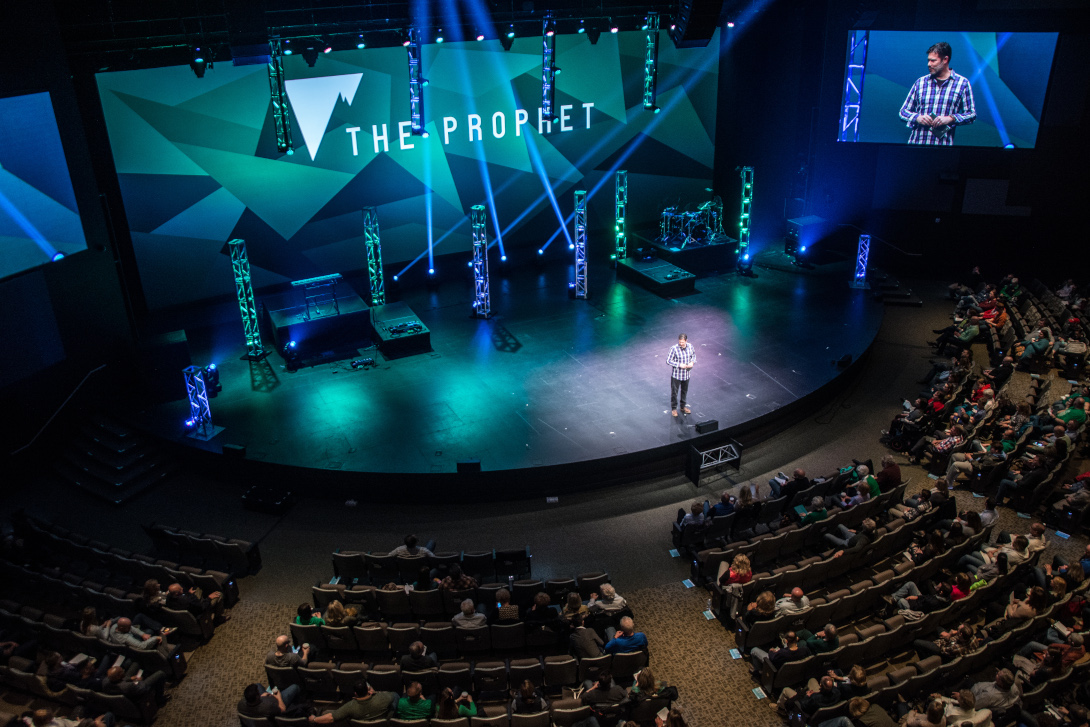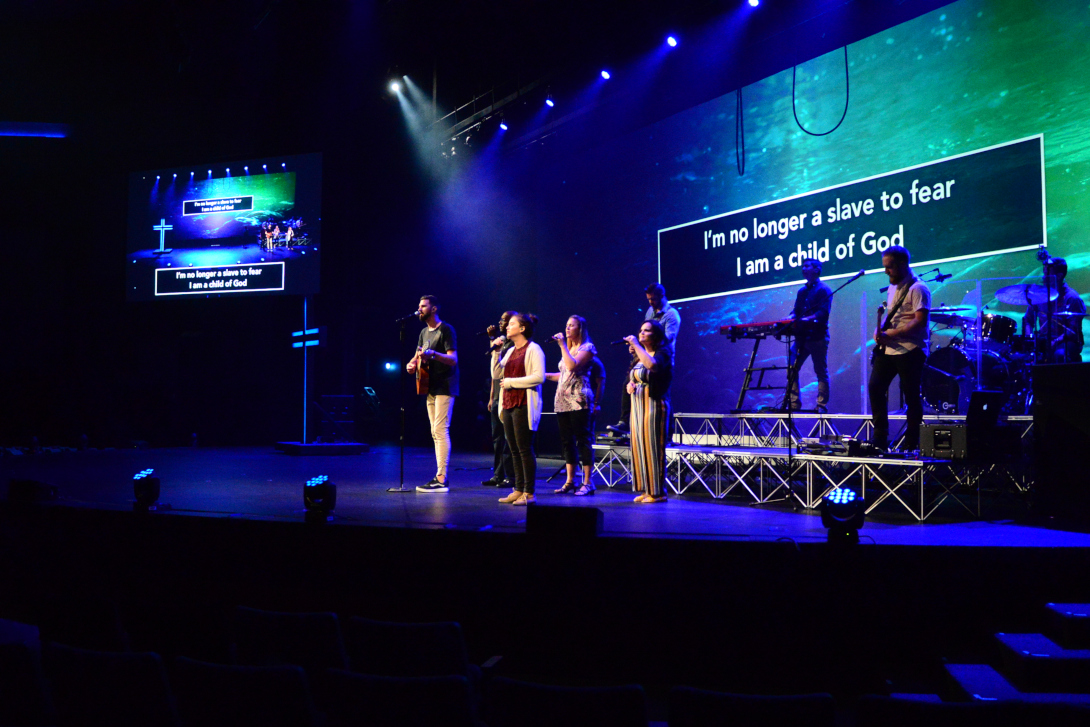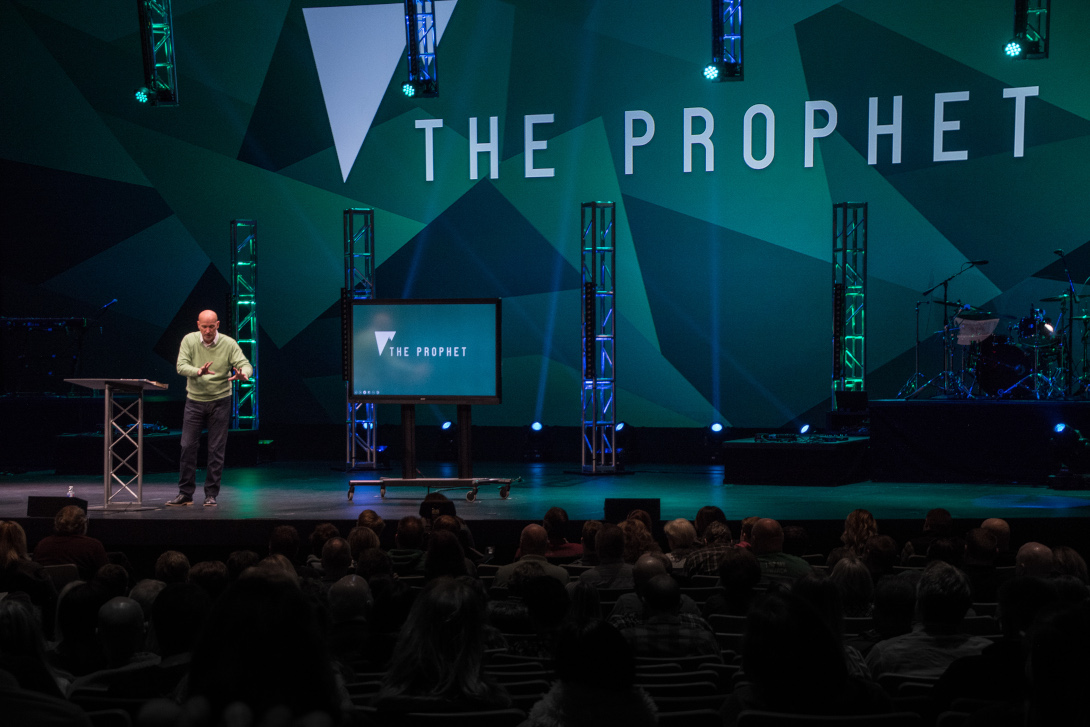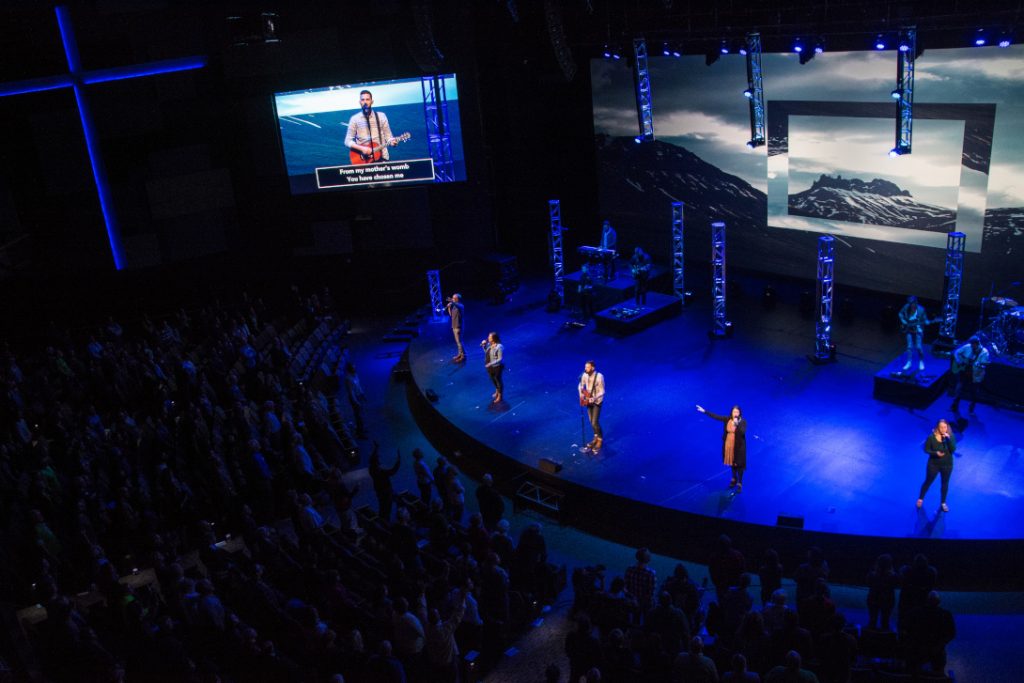An explosion in the use of satellite campuses has transformed the modern worship market. Many churches that host services in multiple locations each week do so by filming services in their broadcast campuses, then streaming or rebroadcasting that video content to remote locations. Churches that take this approach must therefore make significant investments in audio, video and lighting technology in order to ensure that, first, the worship experience that is filmed in the broadcast location is as dynamic and engaging as possible and, second, that worship experience will translate well when rebroadcast to satellite locations.
Indiana-based Northview Church is one of the many churches that have embraced the use of satellite campuses in their ministries, and its technology needs are emblematic of many similar churches. Northview relies heavily on video and lighting technology to enhance its message, as well as to help spread that message beyond the walls of just one building. The church hosts services in seven locations throughout central Indiana, in addition to streaming its services at three Indiana prisons. Northview’s location in Carmel IN serves as its broadcast campus. The building’s fan-shaped main sanctuary eats about 2,200, with two balconies of approximately 500 seats each. The sanctuary’s signature feature is the 30-foot-tall, 80-foot-wide projection screen oriented in the center of the room on the back wall of the stage. The room also has left and right projection screens, which are used for IMAG. The non-denominational Christian gatherings hosted at the Carmel campus kick off with a performance by a contemporary worship band, which is followed by announcements and a spoken-word message.
A service takes place at the Carmel location each Saturday, and the spoken-word portions of each service are recorded for rebroadcast at Northview’s satellite locations every Sunday (the satellite campuses all have their own worship bands that perform in person). Video from the Carmel location is also livestreamed on Northview’s website, and past services are archived for on-demand viewing online.
Northview’s Production Systems Director, Travis Carpenter, further explained how Northview prepares and delivers video content to its satellite campuses. “The video that congregants watch at the satellite campuses on Sunday morning is a recording of the Saturday-night service at the Carmel campus that is edited with some basic ins and outs to create a smoother experience at the satellite campuses,” he said. “Audio is also cleaned up to make sure there are no issues with intelligibility at the satellite campuses. The campuses that are playing the message Sunday morning play back two files synced up. One file is the recording of the IMAG feed at the Carmel campus, and the other file is a locked-off shot of the speaker at the Carmel campus.”

Each of Northview’s satellite campuses feature three projection screens hung left, right and center. “The recorded IMAG feed is displayed on the side screens, and the locked-off center shot is displayed on a 10-foot-tall and 18-footwide motorized drop screen,” Carpenter described. “When framed properly and paired with a high-quality projector, this locked-off center-screen shot creates the illusion that the speaker is actually standing on the stage delivering the message.”
The locked-off shot recorded at the Carmel campus captures not only the speaker on stage, but also the large projection screen located behind the speaker on the back wall. Northview uses the back-wall projection screen to create virtual staging, as well as to add visual themes to support the speakers’ sermons. Consequently, the production of the locked-off shot requires meticulous attention to detail in order to ensure it achieves the desired effect. The speaker must be framed properly within the shot, and the large projection screen on the back wall of the stage must be framed properly behind the speaker.
“The main purpose of the screen is to create a dynamic, constantly changing backdrop that we can use in just about any way we imagine,” Carpenter explained. “The upstage videowall shows primarily motion graphic loops, with the lyrics from our graphics machine overlaid over the video. Most of the motion graphics loops are purchased or pulled from our existing library. With every new series, we change the graphic branding for the service. We heavily rely on the upstage videowall to assist with the change of the environment from series to series. A surface that large plays a huge role in setting the tone and vibe for the auditorium.” Carpenter added, “We have used it from time to time as a set-extension element—anything from Christmas trees to hanging lanterns and a virtual warehouse, we’ve tried various things to make our staging elements look like they extend further back than they do in reality. We have found this is especially challenging to pull off effectively. Getting the scale of items perfect is vital to selling the effect.”
Because the Carmel campus’ backwall projection screen is so important to the worship experience, not only at the broadcast campus, but at the satellite campuses, as well, Northview made that feature the main priority during a recent video upgrade to the Carmel campus. The church wanted to address two issues with the center screen: that the brightness of its lamp-based projectors left a lot to be desired given the large amount of theatrical lighting in the space, and that the sheer size of the screen created some problems with edge blending the projected images.
“Our main expectations were to upgrade our projection system from the aging lamp-based system that we had previously,” Carpenter said. “One of the primary issues with the old system was related to the size of the upstage video wall. Due to its size, we have been edge blending several projectors together to create such a large image. Since the screen itself was so massive, the screen had a tendency to bow out in the middle, as the air pressure in the auditorium and the projection room fought each other. As the screen flexed back and forth, it would throw the projection blend zones out of alignment, which would affect anything on those respective areas of the screen. We also needed more brightness than we had from our previous system.”
To address these issues, as well as to make some improvements to the Carmel campus’ video-switching system, Northview reached out to JNE Productions (www.jnepro.com), whose ranks actually include a few members of Northview’s congregation, including the owner, Jon Cawston. Cawston and his team worked with Carpenter and his assistant, Evan Rodecap, as well as Northview’s Production Director, Nathan Miller, and Pastor Steve Poe, on planning the project.
“The project really started in a conversation about wanting to change their back wall visually to have more impact, and the journey that they took at first was to take a look at LED product and what it would take to do an LED wall,” Cawston said.

One of the main reasons Northview wanted to consider an LED wall was because the church’s production team wanted to be able to repurpose sections of the LED wall to use as staging elements as needed; however, this idea was deemed impractical. “We had a long conversation about that,” Cawston recalled, “and the argument that I presented to them was ‘I see the day when Northview will have LED walls sitting in cases, but the idea of actually taking apart your 100-by-30 LED screen… I don’t see anybody wanting to do that. I see people rolling out cases from the side of the stage and setting up stuff that’s much cheaper or stuff that’s temporary instead of taking stuff apart.’”
Overall, the church found LED to be too cost-prohibitive an option, given the proposed size of the wall and the infrastructure and maintenance that would be required to support it. The LED moiré effect was also a concern, given that the back wall acts as a backdrop for the satellite video feeds. “LED walls give off that moiré look at certain focal ranges on a camera, and their camera locations can’t change in their main auditorium at this point,” Cawston said. “So, that was another main question in the consideration of LED—where would that moiré take effect…at what distance?”
Instead of going the LED route, Northview decided to keep its existing projection screen, but upgrade the Carmel campus’ lamp-based projectors to Barco UDX-4K32 laser projectors, which are already being used at the satellite campuses. This would make all the church’s projection systems uniform, as well as save the church money on lamp changes in the long run, while also solving the brightness issue. “They were running about 15 foot lamberts on that back screen [with their old projectors],” Cawston said. “When we ran the numbers on the Barco UDX-4K32s, we were going to be able to get them 67 foot lamberts onscreen and save them a ton of money.”
JNE conducted a demo of the UDX 4K32s, and that was all the convincing the AV team needed. “We did a test image with Travis and Nathan, and had Pastor Poe come and take a look at a comparison between A and B. So, we put their old projectors up against the Barcos using that back screen. We didn’t do a full back-screen test; we just did a projector against a projector. And they got a chance to see what the 4K was going to look like in their room, and the brightness contrast level, and that just put them over the edge right there.”
Cawston added, “Barco has a great reputation, and their service on all of the projectors that they’ve had up to this point has been impeccable. And for us as a company, as a dealer, they have been remarkable. I know, in one particular case, we had a projector come DOA, and I had a brand new projector the next morning flown in from Brussels. When you get a company that stands behind their product, it’s easy for guys like at Northview to say, ‘Alright, we’re not just paying for a product and trying to save money, we’re paying for somebody that’s going to stand behind their gear,’ and that was part of the conversation.”
Four UDX-4K32s are used for the center screen and edge blended to create one unified image. The projectors are mounted on ground-stacked Grainger mechanical lift tables in a room opposite the center screen that is dedicated to the projection system. “One of the challenges for us was that we put the projectors on these 3,000lb. hydraulic lift tables,” Cawston shared. “They weigh about 400 to 500lb. each, and there was no easy way to get them there, so it took about 10 guys. We hooked up this truss configuration—it was quite interesting—and then we slid them up the stairs because no one could pick them up to get them in there. So, that was an interesting complexity.”
“The other part was getting the blend right,” Cawston continued. “There was a plan as to how the projectors were going to be installed and in what positions. Once they got into those positions, we discovered that there were some things about the blends that we did not like in certain portions of the auditorium. Standing in the center of the auditorium, it looked terrific. When you started to move off axis, you got to a point where you really could see those blend zones really bad. So, we reconfigured the projectors a couple of times to find the best solution, so that you didn’t see those blend zones any longer.” Barco sent a pair of technicians to Northview to offer training on the system and to coach the AV team through the edgeblending process; these technicians also helped troubleshoot the initial edgeblending issues.
The new projection system also includes a Barco Image Pro II processor and a Barco E2 switcher. “Switching out the processor was also a critical path in terms of making edge blending much more efficient and adjustable pretty quickly and easily,” Cawston explained. “Their new processor allows them to do that exceptionally fast and gives them a lot of creativity with very minimal frame loss. And because of the switcher and the amount of processing that the Barco processor can do, they can actually do picture-in-picture on the back wall for the first time in live settings; before, there was so much frame delay that it was never wise.” A Mac Pro running Resolume software sends the center-screen graphical content to the E2 switcher, which is used to send the signal to the projectors. The E2 switcher is also used to overlay lyrics onto the center screen.

Currently, all of the live video content that is fed to the projectors is captured on 1080p Panasonic cameras, but Northview plans to upgrade to 4K cameras in the near future. In the meantime, the video production team uses the processor to upscale the 1080p content to 4K. The live video is recorded using Video Devices Pix270i recorders.
The projectors are currently connected using DVIGear fiberoptic cables, but 12G-SDI infrastructure is in place and ready to go, as well. “They wanted the projectors to run in a 12G-SDI mode,” Cawston said. “The 12G-SDI connectors in the Barcos are still not active yet. They’re building it in, and there’s a software update coming down the way. We’re using the DVIGear fiberoptic cables in the current setting, but we pulled Belden 12G-SDI cable for when the 12G goes live.”
An additional two UDX-4K32s are used to project IMAG shots onto the side screens; these were also upgraded in order to improve the brightness of the images on the side screens. “Pastor Steve always felt that all of the projection never amounted to what he wanted in the original design, but now he’s thrilled,” Cawston said. “In fact, it’s so bright now that they have to turn the projectors down because they can’t make the room black anymore. So, when the side screens are on for the bumper video that plays when the band walks off and the pastor’s getting ready to come up onstage, the side beams are so bright you can see everything happening on the stage, despite the fact that those screens are 130 feet apart from each other. And then the other thing that they found was, with the projectors at 100 percent, the screen was so much brighter than all the lighting. They’re in the process now of redoing all of their movers, because they now have to get more punch to help compensate for the brightness of the screen.”
“The side screens are used for IMAG and video playback,” Carpenter said. “Videos created in-house for weekend services are created by our video team using Adobe Premier and Adobe After Effects.” The video feed that usually appears on the side screens can also be sent to the center screen if necessary. A computer running ProPresenter is used to add lyrics to the side screens, as well as to send lyrics to the confidence monitors facing the stage.
The side-screen projectors are fed by a Ross Acuity switcher and controlled via a Ross Ultrix router/multiviewer system. This system was designed in-house by Northview’s production team, and JNE assisted with the installation. The video production team uses Clear-Com Eclipse HX and FreeSpeak II wireless systems to communicate during services.
Northview also requested two extra UDX-4K32s in road cases to be used as spares. “If a satellite campus’ center screen ever went down, they never had anything [to use as a spare], so they wanted two projectors that were going to remain available to move around as needed,” Cawston said. “When we put in the lift tables, we built a structure that the Barco frame locks into, so if they ever have to change the projector, they don’t have to figure out where to put it again. They actually just pick the frame up and it slides right into place, exactly where it was before, because that is a nightmare if you’re off a little bit to the left or off a little bit to the right. And the hydraulic tables, because the projectors weigh 200lb. each, make it easier for them to service the projectors.”
During the spoken-word message portion of the service, a 70-inch Sharp touchscreen is rolled onto the stage. This touchscreen is used by the speaker as a visual aid, and is positioned in such a way that it will be in the frame of the locked-in recorded shot that appears on the center screens in Northview’s satellite campuses. According to Cawston, this approach gives the speaker the ability to interact with the onscreen content in real time, which increases audience engagement, and it eliminates the task of adding graphics to the recorded video feed or splicing in full-screen graphics.
“It’s very volunteer friendly,” Cawston said. “You can work it like PowerPoint—it’s just next slide, next slide, next slide. And it’s a touchscreen, so the pastor can make his own changes.” He added, “You’re seeing a lot of these show up in churches right now, and the reason is that the old way of [adding graphics] was so time-consuming for the tech team every week, and you can avoid cutting your senior pastor’s face off and just putting a full-window graphic up, counting for five seconds, and then taking it off. By having the touchscreen there, it allows the online viewer and the satellite campus to see pastor and never lose his eyes.”
Although this particular installation was focused on the Carmel campus’ video system, JNE did install some new Shure ULXD wireless microphone systems. The venue’s existing audio system consists of three Meyer Sound Melody line arrays flown left, right and center, a Solid State Logic L500+ front-of-house audio console and a Yamaha CL5 console that is used to mix the in-ear monitor system.
Northview was pleased with the upgrade to its broadcast campus’ video system, and the church had nothing but praise for JNE. “The team at JNE Productions consistently goes above and beyond to deliver an excellent product, handling all of the minute details so that I can keep up with the day-to-day issues at Northview and keep pushing other projects forward,” Carpenter said.
And Cawston has received plenty of positive feedback from his fellow Northview attendees, as well. “My wife has a lot more connections in the church than I do,” he shared, “and her phone on that first Sunday morning just started to light up with people telling her that the screens look awesome—they’re amazing.” You can’t do much better than that.
